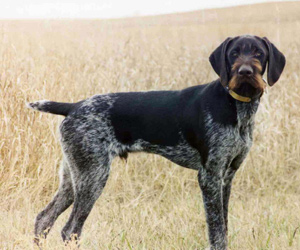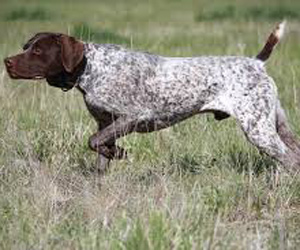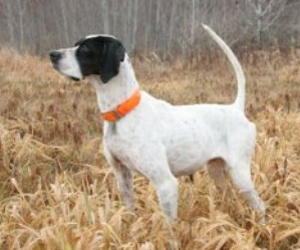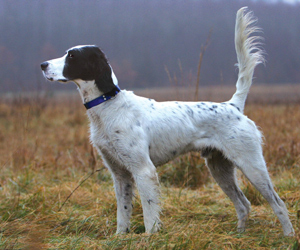I live at the base of a chukar hill. The little striped devils laugh at me from across the park just across the street. In the summer they come down from the dry rocky slopes to drink from the sprinklers and cackle-laugh away as they strut around on the lawn. In the winter you can see them perched up on top of the rocks, a couple of the bigger birds on lookout duty. I love chukar hunting, for many of the same reasons I love fly fishing. It’s challenging and rewarding and the dog work on chukars is remarkable to watch.
I’ve been around bird dogs most of my life and I had one if not two dogs, several of them English Setters for about 20 years or so. But I’ve spent the last 4 years or so without a hunting dog. I’m thinking it’s about time again. For me anyway. Em may disagree. We’ll see how that discussion plays out.
So, with this backdrop, I’ve spent some time recently thinking about getting another bird dog. This leads to the question: Which breed is the best bird dog is best for western upland bird hunting? Which dog works best on chukars, pheasants, Gambel’s quail, valley quail, ruffed grouse, blue grouse, sage grouse, and huns in wide open spaces, mountains, forests and marshes? This is a lot to ask, but it’s the reality of Western bird hunting. Oh, and I have to like them. What is the best hunting dog breed for all these requirements?
I’m openly biased on the matter, I like pointing dogs, dogs with personality, and dogs with a lot of drive and this is just my opinion on these breeds. Having guided pheasant and chukar hunts for over a decade at probably one of the best clubs in the West, I’ve hunted with and been around all of these breeds and many more. So, maybe my opinion can help you make the decision on which breed of bird dog is best for you as well, but take it with a grain salt. Here’s my short list.
Drahthaar

The Low Down: The Drahthaar is classified as one of the versatile breeds. These bird dogs point, retrieve, swim, and even track. Amongst these breeds the Drahthaar is kaiser. This is the actual German, certified, version of what has become known as the German Wirehaired Pointer. Drahthaar breeding is controlled and monitored closely to ensure that the standards of the bloodline are maintained.
Pros: Drahts are incredible dogs. I’ve witnessed this firsthand. They swim well and have tough thick coats that can handle essentially any weather. They are strong dogs and since their breed standards are so strict, you can be sure you’re getting a quality bloodline almost every time. They are strong retrievers, good pointers, and they work at a reasonable range.
Cons: As they are known as something of a super breed, some Draht enthusiasts may debate some of these cons but I’m basing this on what I’ve seen and experienced with these dogs. Drahts, in general have good noses, but not great. They are big dogs, especially the males, so they take a good deal of space and eat more food. Drahts are likeable but not generally full of personality. The most troubling thing I think is their tendency to be quite protective and dominant. I’ve seen Drahthaars nip at other dogs and people just a bit too often to feel comfortable around them.
German Shorthair
 The Low Down: The German Shorthaired Pointer, or GSP as they are often called, is possibly the most common and widely distributed breed of bird dog in the world today. There are certainly a lot of them here in the West. These are prototypical pointers with a strong retrieving instinct.
The Low Down: The German Shorthaired Pointer, or GSP as they are often called, is possibly the most common and widely distributed breed of bird dog in the world today. There are certainly a lot of them here in the West. These are prototypical pointers with a strong retrieving instinct.
Pros: German Shorthaired Pointers are great pointers with above average noses and they look awesome. They work hard and generally have a strong bird drive. Their coats are short and tight and require very little maintenance. GSPs are also great retrievers and decent swimmers if you show them how.
Cons: People who love their shorthairs may disagree, but a lot of GSPs just seem aloof to me, not really people dogs. They think it’s fine if you’re around but don’t have that personality that makes you think they really love you. Also, if you’re careful, you can find great breeders but, because they are so popular, there is more poor breeding of GSPs out there. You have to be careful.
English Pointer

The Low Down: The perennial champion at most field trials, the English Pointer is a bird finding machine. These dogs are all about speed, style, and outdoing every other dog out there. There has been more time, money, and effort that has gone into the breeding of the English Pointer than probably any other bird dog.
Pros: I think that the English Pointer, in general, has the best nose out there. I’ve seen them pick up the scent of a single bird on a dry day at impressive distances. English Pointers have incredible motors and a ton of bird drive. They live for it and are willing to practically run through brick walls to find birds. They are fast and have impressive stamina. Their short coat is nice in that it requires very little brushing.
Cons: English Pointers can be just plain knuckleheads. Their drive can outpace their brain. Their range is often too big for most walking gun hunters and reigning them in can be a tough task. They aren’t usually great natural retrievers. Also, English Pointers, like Shorthairs, aren’t really people dogs. They can be reasonably friendly but aren’t usually your best buddy. Lastly, English Pointers have a really short coat that makes them susceptible to getting cold, that’s a problem in the West. Oh, and they usually won’t swim much.
English Setter

The Low Down: The English Setter was once quite large, slow, and aloof as they sauntered about the grouse forests of the Eastern states with an aire of nobility and culture seemingly brought on a boat from the motherland. What a long way they have come. Although there are still bloodlines that are big, slow, and hairy out there, smaller faster English Setters have transformed this dog into one of the best field trial and gun hunting breeds. They are gaining in popularity but there are still far fewer setters than either English Pointers or German Shorthairs.
Pros: Second maybe only to English Pointers, the English Setter has a great nose. The modern trial-bred lines of English Setters have a ton of drive, birdiness, and great stamina. English Setters are great people and family dogs. They aim to please and genuinely like to hang out with you. They are medium to small hunting dogs, which makes caring for them a bit easier and less expensive. They are decent retrievers and can be good swimmers if you teach them. The best thing, they do all of this with style. No other breed moves as fluidly, points with such staunch beauty, and looks as cool and confident in doing it.
Cons: English Setters, at least the trial lines, can be a bit rangy. You have to work to keep them close, especially if you’re working jumpy birds. Their longer coat of hair can be a serious hassle to keep free of burrs and briars, but it does help them stay a bit warmer than say English Pointers. Since they like people so much, English Setters can be a bit needy. They will be your best buddy, whether you like that or not.
The Decision?
So, without further ado, which breed will I be going with? Well, this was never a fair fight. It was rigged by my bias from the beginning because I simply love the last breed on my list, English Setters. I just connect with them. Many dog people will understand. You can’t always say why you love a breed but you know you do. I’ve seen incredible dogs from all of these categories and many other breeds as well (I almost included the Brittany Spaniel and Pointing Labrador Retriever).
But, I love English Setters. So, now that this is out there, Em and I need to have a discussion and I’ll report how that goes. Feel free to share your opinions on this in the comments. I’d love to see if you can sway me because I am not looking forward to picking burrs from English Setters long hair for the next 10 -15 years.
I currently run an 8 year old Spinonie Italiano and she is the best dog I’ve ever been around. Keep in mind I’m getting old so I need a dog I can keep up with and she works very close. She has a great nose and never misses a bird. She is also the best family dog I have ever been around.
They are hard to find and not seen very often so not a dog on most peoples radar.
That’s awesome. I’ll have to check them out. Looks like a really versatile breed.
Jake
See if you can get a two for one deal?? ;}
After you’ve let a setter in your life…..the only question is when will you get your next…… Hunted 14yrs over my gal.
My 2 sons and I still can’t talk about her very long without getting choked up….
I agree with your vote 100%
Agreed!
I’m curious if a Llewellyn setter would have the same nose and talent but maybe work closer when they hunt and be a little smaller for the house?
Most of the Llewellin setters I’ve been around are great dogs, but I’ve not been as impressed with their noses in general. Maybe, because the trial dogs have been selected for noses specifically. Good if you’d like a close worker and a great companion after the hunt though. They’re actually a little bigger than most trial setters but still quite manageable.
I have had GSP’s for about 30 years. I live in Texas, hunt deer, pigs, dove and quail in state and pheasant, sharpies and Huns every year in Montana. My GSP’s pretty much have done it all from pointing and retrieving birds to tracking wounded deer. Their hunting and retrieving skills have varied from dog to dog but all have been good solid hunters and have been recognized as such by other hunters. Every one of them however have been exceptional family dogs and good house dogs, trustworthy around small kids and in public areas. In my opinion, that is one of the breed’s strong points. However, I also believe that a dog’s personality and manners is as much of a function of environment and handling as breeding.